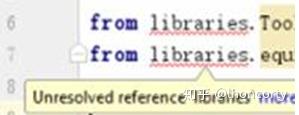
We hope these new refactoring features will improve your user experience with P圜harm. '': './path-to-code/', I tried this before, but not working.
Pycharm unresolved reference code#
Note that you can also add a parameter using the dedicated Extract Parameter refactoring.Īfter applying changes, a new code will be generated with the new signature propagated through the method call hierarchy: Add new parameters and remove the existing ones.To try it, in the editor place the caret on a function name and press Ctrl+F6.Īlternatively, select Refactor > Change Signature from the main menu to open the same dialog:
Pycharm unresolved reference update#
With Change Method Signature you are able to refactor a signature of the selected method and update its calls in your project. Note: For more information on quick-fixes, please refer to “Resolving Problems” in Help. In case of an unresolved symbol, you can easily apply the Create Parameter quick-fix for that, making it a parameter of the function. For example, if you hover over the math.sqrt() function call in the main() function, a popup will appear saying Unresolved reference 'math' to indicate that. Here is an example of the extract variable on a substring with the new-style formatting:

After the template tag STATICURL, start typing, and then use Ctrl+Space. In the pre-configured directory for templates, create a template file ( Alt+Insert - HTML/XHTML file ). This feature is available to be performed “in-place” by default, or through a dialog. To refer to static contents, follow these general steps. Use it to put the result of the selected expression into the function argument list. The Extract Parameter refactoring allows you to add a new parameter to a function declaration and update the function calls in your project.


This is why Pycharm doesn't know that there are Queue and Process classes in the multiprocessing module. edit: screenshot using P圜harm 3.4.1 (it's quite well hidden) There are many solutions to this, some more convenient than others, and they don't always work. So in reality, Queue is never defined in the module itself, but rather through some dynamic code, it gets set correctly at runtime depending on the user's operating system. Return Queue(maxsize, ctx=self.get_context()) Now what is this context._default_context? If we look in multiprocessing\context.py, we see class BaseContext(object):
Notably there is nothing in the file that looks like Queue, Process, etc. Unresolved reference issue in P圜harm, In P圜harm menu select: File -> Invalidate Caches / Restart a missing package problem, just place the caret at the unresolved reference and After following the accepted answer, doing the following solved it for me: File Settings ProjectGlobals().update((name, getattr(context._default_context, name))įor name in context._default_context._all_) If we look in multiprocessing\_init_.py, we see the following: #


 0 kommentar(er)
0 kommentar(er)
